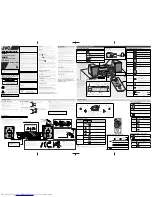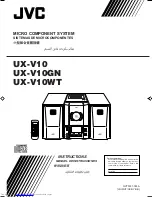
6
Introduction
Thank you for choosing a TAPCO
®
Tweeq™ 31-band graphic
equalizer by Mackie
®
. The TAPCO product line hails back to the
days of TAPCO Corporation, Greg Mackie’s fi rst company. TAPCO
revolutionized the audio industry back in 1969 with the very fi rst 6-
channel mixer specifi cally designed for keyboards and rock ‘N’ roll PA.
In essence, TAPCO redefi ned the price performance ratio and
made high-quality professional audio mixers accessible to virtually
anyone. Today, TAPCO is reborn with the same ideals and is backed
by the world-class engineering and manufacturing horsepower of
Mackie. The TAPCO T•231 is the fi rst graphic equalizer in the TAPCO by
Mackie
®
family.
About Graphic Equalizers
The tone controls on your home stereo system typically have a bass and treble control,
and sometimes a midrange control, that you use to boost or cut a broad band of
frequencies. When you leave the controls in the center position, they do nothing.
A graphic equalizer works in much the same way, except that it has many more controls
that operate over much narrower frequency bands. The T•231 has 31 controls that boost or
cut different frequencies, each centered on ISO standard frequencies ranging from 20 Hz
to 20 kHz and affecting 1/3 of an octave.
Constant Q Design
The T•231 is designed with constant Q fi lters. The Q of a fi lter refers to its quality. A fi lter
with a low Q affects a broader band of frequencies than a fi lter with a high Q (Q=f
c
/BW, for
you technoids!). Constant Q means that, as a slider is boosted or cut, the bandwidth of the
fi lter (the “skirt” of the affected frequencies) remains the same. Lower quality proportional
Q fi lters have a broader bandwidth as the fi lter is boosted or cut, which can extend out to
an octave or more.
Whazzit Used For?
There are a number of uses for graphic equalizers in a sound system. They can be used
to correct the frequency response of a loudspeaker, or to adjust for resonant peaks and
dips in a room. Sometimes they are used to simply bring out the characteristics of a voice or
instrument to improve the intelligibility and articulation of the sound.
In any case, please remember that a graphic equalizer is a tool that can be used to
improve the overall sound, but it cannot make up for frequency response defi ciencies
caused by poor system design or poor acoustics. Try and get the best possible sound
from the system before attempting to use equalization by paying attention to proper gain
structure and loudspeaker placement. Often times just moving a loudspeaker to a different
position can have a dramatic effect on the overall sound in the room.
Probably the most common use of a graphic equalizer is placing it in-line between the
mixing board’s main outputs and the power amplifi er inputs (see hookup diagram on page 8).
When used with a real-time analyzer and pink noise generator, it can be used to fi ne tune
the acoustic frequency response and get it as fl at as possible in a room.
TAPCO version of Greg
TAPCO van (a.k.a. micro bus)
Содержание Tweeq T-231
Страница 20: ...tapcogear com...






































